February 29, 2008
Air Date: February 29, 2008
FULL SHOW
SEGMENTS
Green Jobs For Blue Collar Votes
/ Jeff YoungView the page for this story
The leading candidates for president are all counting on clean energy to create new jobs. But will those political promises come to pass? Living on Earth's Jeff Young says the election year battleground state of Ohio could offer some answers. (06:30)
Economy of Green
View the page for this story
Creating green jobs in the next decade will spur the American economy towards future growth. That’s according to Dr. Joseph Stiglitz, a 2001 Nobel Prize winner and economics professor at Columbia University, who talked with host Steve Curwood. (05:15)
Exxon Valdez in Court
View the page for this story
Exxon-Mobil refuses to pay two and a half billion dollar in punitive damages to Alaskan residents affected by the tragic oil spill that happened 18 years ago. Both sides of the court case say it’s not about the money. Living on Earth host Steve Curwood speaks with Travis Vlasoff, a plaintiff in the case from Tatitlek, Alaska and Jennifer Gibbins, the soundkeeper of Prince William’s Sound. We also hear from Ken Cohen, vice president of public affairs for Exxon-Mobil. (16:00)
Emerging Science Note/Diatoms
/ Margaret RossanoView the page for this story
Sea algae may be the key to faster computer chips. Living on Earth’s Margaret Rossano reports. (01:50)
This Is Your Brain on Poverty
/ Emily TaylorView the page for this story
Recent research suggests that the stress of poverty may lead to problems with memory and language skills. Living on Earth's Emily Taylor reports. (05:15)
The Language of Landscape
View the page for this story
Living on Earth continues its series exploring features of the American landscape. It’s based on the book “Home Ground: Language for an American Landscape,” edited by Barry Lopez and Debra Gwartney. In this installment, Eva Saulitis explains the term “pack ice.” (03:15)
Leaping Towards a Solution
View the page for this story
What better way to celebrate leap year than by highlighting the plight of our amphibian friends? A third of the world’s frog populations face extinction. Host Steve Curwood speaks with Shelly Grow, of the Association of Zoos and Aquariums, about their efforts to highlight the problem with a series of exhibits and events. (06:15)
This week's EarthEar selection
listen /
download
Pig frogs, with grace notes from Cricket and Carpenter Frogs, serenade from the Okefenokee National Wildlife Refuge in Georgia.
Show Credits and Funders
Show Transcript
HOST: Steve Curwood
REPORTERS: Jeff Young
GUESTS: Ken Cohen, Jennifer Gibbins, Shelly Grow, Joseph Stiglitz, Travis Vlasoff
[THEME]
CURWOOD: From Public Radio International- this is Living on Earth.
[THEME]
CURWOOD: I’m Steve Curwood. With a wobbly economy one seemingly bright spot is the promise of millions of so-called green collar jobs related to renewable energy and conservation. But it’s still just a promise.
BEZDEK: It’s not going to be easy, it’s not going to be cheap and it’s not going to be quick. The good news is that green collar jobs is a new motherhood and apple-pie type of thing that- everyone’s in favor of it.
CURWOOD: Also – 19 years after the Exxon Valdez disaster Exxon is still fighting a large punitive damage award in the face of protests.
GIBBINS: It’s not about the money, it’s about justice, and it’s about holding Exxon accountable and it’s about the fact that they did the crime they need to do the time. And in this case, the time is paying the punitive damages.
CURWOOD: But Exxon says it’s already done enough and deserves no more punishment. We’ll have that and more this week on Living on Earth – Stick around!
ANNOUNCER: Support for Living on Earth comes from the National Science Foundation and Stonyfield Farm.
[MUSIC: Boards Of Canada “Zoetrope” from “In A Beautiful Place Out In The Country” (Warp Records 2000)]
Green Jobs For Blue Collar Votes

Clean energy for Cleveland? Both Democratic candidates used the recent debate in Ohio to say green jobs can ease Ohio’s blue-collar blues. (Photo: Cleveland State University)
[THEME]
CURWOOD: From the Jennifer and Ted Stanley studios in Somerville, Massachusetts, this is Living on Earth. I’m Steve Curwood. For years we’ve heard politicians talk about the economy versus the environment: If you want cleaner air and water, it’s going to cost you – lost jobs, higher prices.
But in the presidential campaign of 2008 that paradigm has shifted. Now all the major candidates talk about the environment helping the economy.
CLINTON: The clean energy agenda is a jobs agenda.
MCCAIN: We will stimulate green technologies. This will be profit-making business.
OBAMA: Reducing energy consumption isn’t a drag on our economy, it is the future of our economy.
CURWOOD: Senators Clinton, McCain and Obama all see green-collar jobs in the future – jobs generated by a massive shift in the energy industry. But how realistic are these electioneering promises. Living on Earth’s Jeff Young has been finding some answers.
MACEWAN: I invite you to join me in a sunny, Solar Integrated welcome for Governor Arnold Schwarzenegger, the people’s governor.
[APPLAUSE]
YOUNG: When California’s Arnold Schwarzenegger endorsed Senator John McCain for president, he made the announcement in a solar power equipment company in Los Angeles.
SCHWARZENEGGER: This is a perfect place to talk about our shared commitment to protecting the environment and to stimulate the economy at the same time.
YOUNG: Schwarzenegger and McCain are probably the most prominent Republicans to embrace reductions in greenhouse gases as a positive step for the economy.
MCCAIN: With the development of green technologies, we can have reduced costs to the American consumer.
YOUNG: And California is proof. Solar companies alone produced thousands of new jobs there thanks to aggressive state policy, innovative local organizers and abundant venture capital. Well that’s great for sunny California, but you rarely hear people talk about sunny Toledo or Akron. Yet Mid-western, rust belt Ohio is where the presidential candidates are really pushing green jobs. It’s a crucial battleground state where the issue is jobs – capital “J”. Listen to Senators Barack Obama and Hillary Clinton at the recent MSNBC debate in Cleveland.

Clean energy for Cleveland? Both Democratic candidates used the recent debate in Ohio to say green jobs can ease Ohio’s blue-collar blues. (Photo: Cleveland State University)
OBAMA: The potential for creating green jobs that can not just save on our energy costs but, more importantly, can create jobs in building windmills, that will produce manufacturing jobs here in Ohio.
CLINTON: I want to see people throughout Ohio being trained to do the work that will put solar panels on roofs, install wind turbines, do geothermal, take advantage of biofuels – these are jobs that have to be done in Youngstown, in Dayton, in Cincinnati.
YOUNG: Both Democrats propose multi-billion dollar investments in clean-energy technology and job training. McCain’s proposal is less detailed but he also sees robust job growth. And Ohio could sure use some- it’s lost tens of thousands of manufacturing jobs. But some argue that the candidates’ proposals could make things worse. Ken Green is a resident scholar at the American Enterprise Institute, a free-market-oriented think-tank. Despite his name, Green does not buy the green jobs agenda.
GREEN: But in reality these are not new jobs. What happens is government is going to be breaking jobs in a different energy sector, and they’re going to be giving some of those jobs over to the renewable sector. But because the renewables are not competitive economically, there will be less jobs on net rather than more.

Ohio Sen. George Voinovich-R warns that shifting the economy to address climate change could hit Ohio hard: “What am I supposed to say to the families on the wrong end of the shift?”
(Courtesy of U.S. Senate)
VOINOVICH: Significantly decreasing household income while significantly increasing energy prices and driving businesses overseas. What am I supposed to say to the men and women, families and communities who find themselves on the wrong end of the shift?
YOUNG: But Ohio’s current governor dismisses such talk. Democrat Ted Strickland wants a clean energy standard for Ohio, with a quarter of its energy coming from either renewables like wind or solar, or “advanced” technologies like coal that captures carbon emissions.
STRICKLAND: If you just knew the companies that contact my office, many of them from other countries, who are interested in reducing renewable sources of energy in Ohio, this is a way to create thousands of high paying manufacturing jobs in Ohio. And for those who imply that green technology somehow will cost us jobs, well it’s quite the opposite.

Ohio Gov. Ted Strickland-D is pushing his state to produce more renewable energy and put Buckeyes back to work on wind and solar equipment. (Courtesy of Ohio Office of the Governor)
BEZDEK: What Ohio can gain, to stop or at least alleviate the hemorrhaging of manufacturing jobs that has occurred over the past decade – I’m not saying this is the entire answer to all these states manufacturing woes, but it can be a major part of the solution.
YOUNG: Bezdek found Ohio could gain two point two million jobs in renewable energy and the larger business of energy efficiency over the next 25 years. “Could” is the operative word here. And Bezdek is quick to point out that those figures assume a very aggressive government approach to incentives and investments. And he warns there is already stiff competition. European wind giant Vestas was considering a new facility in Ohio, but chose wind-friendly Colorado instead.
BEZDEK: You just can’t go into a place like Ohio and say ‘well, we’re gonna wave a magic wand and next year we’re going to have 500,000 green-collar jobs in manufacturing. It simply doesn’t recognize the fact that Ohio’s already behind the curve in many of these areas.
YOUNG: What should Ohioans make of the message they’re hearing from candidates. Is this a good economic medicine that they’re peddling here?
BEDZEK: I mean I guess the good news is that renewable energy, energy efficiency, green collar jobs is a new motherhood and apple-pie type of thing that everyone’s in favor of it. And promises are cheap, and it’s not going to be cheap, it’s not going to be easy, and it’s not going to be quick.”
YOUNG: For all of Bezdek’s caveats and cautions, his study’s numbers are eye-popping. Even moderate government support could yield four million jobs nationwide just in renewable energy. And if the U.S. really went all out for clean energy and efficiency, the payoff could be 40 million jobs by the year 2030. Nearly one in five American paychecks would be some shade of green. For Living on Earth, I’m Jeff Young in Washington.
Related links:
- Read Roger Bezdek’s green jobs study, commissioned by the American Solar Energy Society
- A coalition of business labor and environmental groups formed the Apollo Alliance to promote green jobs
- You can hear Living on Earth’s interview with Van Jones, who’s connecting green jobs to the inner city…
- …and get all of LOE’s campaign coverage
Economy of Green

Dr. Joseph Stiglitz is a professor at the Columbia University Business School. (Courtesy of Joseph Stiglitz)
CURWOOD: Ramping up a fundamental change in the energy business to create green jobs is not exactly a small task. Trillions of dollars and millions of people are still tied to fossil fuels. But oil and gas would lose billions in subsidies that would then be devoted to renewable fuels if a bill that just passed the House of Representatives can get through the Senate and past a presidential veto. Still, when the next president takes office, there will be calls to make good on the promises to generate green jobs.
Nobel Prize-winning economist Joseph Stiglitz chaired the Council of Economic Advisors during the Clinton Administration. I asked him what steps the federal government needs to take to stimulate the creation of green energy jobs.
STIGLITZ: By and large the private sector works pretty well, if the incentives are right. The problem right now is the incentives aren’t right. There aren’t the right incentives that reflect the true, what you might call ‘green costs’ associated with anything we do. There aren’t the costs reflecting the scarcity of water, the scarcity of our atmosphere, global warming – these aren’t reflected in the prices and the result of this is firms don’t have the right incentives to do the right thing.
CURWOOD: How do you change that?
STIGLITZ: In one way or another, you have to price these things that we’ve traditionally treated as free – realize that they are scarce. For instance, a carbon tax would take into account the fact that every time emissions are created, it increases the cost. And that’s a social cost. It’s a cost that everybody in the world suffers. So if you charge for every ton of carbon that’s emitted in the atmosphere, a certain amount- that will induce people to economize on emissions and that will provide the incentives to innovate, the incentives to invest in the right way. Many of these investments are long-term investments, and so you have to assure people that this is not just a temporary tax, this is something that’s a long-term problem of our globe. It’s not going to go away in a year or two; it’s with us forever.

Dr. Joseph Stiglitz is a professor at the Columbia University Business School, and won the 2001 Nobel prize for economics.(Courtesy of Joseph Stiglitz)
STIGLITZ: Well I think there may need to be a government program to put a little bit of impetus into it initially – do some of the training, provide some of the seed capital – to help the private sector, jumpstart the private sector. But you know, Americans are very adaptable. Fifteen years ago, there wasn’t such a thing called the Internet, but we learned very quickly how to adapt to this new world and I think the same thing’s true about green jobs.
CURWOOD: What went wrong with ethanol? That’s a lot of green employment there for farmers and yet a farmer right now in Iowa can only get $1.70 a gallon for his ethanol when it sells for $2.40 in New York because I guess there’s transportation problems, infrastructure. What went wrong when the government planning for that?
STIGLITZ: Well actually the problems with ethanol are far deeper. The fact is America should not be producing corn-based ethanol. American corn-based ethanol entails a 50 cents a gallon subsidy and we’re at the same time taxing sugar-based ethanol imported from Brazil by 50 cents a gallon. The fact is that corn-based ethanol has been, you might say, a swindle that has been imposed on America in the name of green jobs, in order to subsidize a few corporate interests. If you look at the actual green benefit of corn-based ethanol, it’s actually very weak. And if we had a comprehensive accounting – a green accounting – that talked about the transportation costs, the production costs, how much resources are used in the production of this, we would find it a real problem.
CURWOOD: Professor Stiglitz, what’s the potential for green jobs? I mean, how many could there be in your view?
STIGLITZ: This is probably the big new industry of this century. The Internet was the big thing at the end of the last century. I think adapting our entire economy to the new realities is going to be the main spur to our economy in the coming decade.
CURWOOD: So what we do about green jobs will really determine how well we grow or don’t grow.
STIGLITZ: That’s right.
CURWOOD: Joseph Stiglitz chaired the Council of Economic Advisors during the Clinton administration.
[MUSIC: DJ Food “Freedom” (Fila Brazilia Remix) from La Gare (Le Maquis 2000)]
[MUSIC: Paul Bley: “Ida Lupino” from Closer (ESP Disc 2008)]
Related link:
Dr. Stiglitz' Homepage
Exxon Valdez in Court

On March 24, 1989, the oil tanker Exxon Valdez ran aground in Alaska's Prince William Sound, spilling 11 million gallons of oil. (Photo: Alaska State Archives)
CURWOOD: It’s Living on Earth, I’m Steve Curwood. Nearly two decades have passed but people in Alaska haven’t forgotten the environmental catastrophe that struck one March night in Prince William Sound.
[MEN SPEAKING OVER RADIO]
CURWOOD: It began with a midnight message to the Coast Guard from the oil tanker Exxon Valdez. The voice on Ship-to-Shore Radio was Captain Joseph Hazlewood.
[HAZLEWOOD SAYS INTO RADIO ‘IT’S VALDEZ BACK.’ HE SIGHS AND SAYS ‘WE’VE FETCHED UP HARD AGROUND’]
CURWOOD: 'We’ve fetched up hard aground,' the captain said. His supertanker was stranded, bleeding oil into the sea.

On March 24, 1989, the oil tanker Exxon Valdez ran aground in Alaska's Prince William Sound, spilling 11 million gallons of oil. (Photo: Alaska State Archives)
CURWOOD: On March 24th, 1989, the Exxon Valdez veered outside normal shipping lanes to avoid icebergs. It was night, but the tanker continued at full speed ahead. The ship hit a reef, ripping a half dozen holes in the hull.
LAWN: It’s hard to describe the wall of death that came out from underneath the ship and spread across the sound and killed almost every living creature that it touched.
CURWOOD: Dan Lawn of the Alaska Department of Environmental Conservation was among the first to respond. He videotaped the ship from a small boat, describing what he saw.
LAWN (on videotape): We’re approaching the Exxon Valdez. She’s hard aground.
LAWN: When we got next to the ship, our boat was floating in oil. There was a wave of oil coming out from underneath the ship that was approximately two or three feet higher than the surface- the liquid around it.
LAWN (on videotape): We’re looking at the hull of the ship. You can see a black oil line right here.
LAWN: The smells were- it was kind of like having your nose in the gas tank of your car.
[NEWSCASTER REPORTS ‘THE PORT OF VALDEZ HAS BEEN CLOSED AS THE RESULT OF A MASSIVE OIL SPILL BY AN EXXON TANKER . . . ’]
CURWOOD: News of the accident broke on local radio. It was the biggest spill ever in American waters. The official estimate: 11 million gallons of oil.
MAN: I want to assure everyone that Exxon is mobilizing all available resources to mitigate the impact from this incident. Exxon has assumed full financial responsibility for the incident.
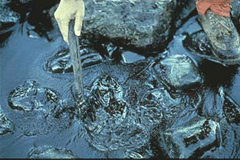
Pools of oil that leaked from the Exxon Valdez on a rocky beach in Alaska. (Courtesy of NOAA)
Still, Exxon Mobil is fighting punitive damages. An appeals court has already cut the amount awarded by a jury to two and half billion dollars and now Exxon Mobil is asking the U.S. Supreme Court to throw out that award altogether.
Many Alaskans are adamant that Exxon should be punished. They say Alaska is still reeling from the fouling of 1,200 miles of prime coastline while Exxon is making record profits. Travis Vlasoff is a Native Alaskan from the village of Tatitlek.
VLASOFF: There was a- just a great volume of oil. It’s hard to really convey how much oil there was. It was very, very thick on top of the water. Initially several feet thick. And there was just an incredible amount of wildlife and was either covered in it or obviously, you know, not the best of shape or already passed away.
CURWOOD: What did it smell like?
VLASOFF: It smelled like chemicals. It gave a good amount of the initial responders nose bleeds- just a horrible substance.
CURWOOD: Back in 1999, Living on Earth visited Cordova and we spoke with some of the men and women who fished there. I’d like to play you what Sheelagh and Ross Mullins had to say.
SHEELAGH: My permit was worth $150,000. I couldn’t sell it today. You know, where does that leave me? That was my pension, my retirement.
ROSS: The people that are here, a lot of them have seen some real serious economic consequences. You can’t say it’s 100 percent entirely devoted as a result of the spill but I would say at least 50 to 75 percent of it is. So, there’s a lot of angry people in this community still.
CURWOOD: So Travis, eight years on what’s the situation in your village?
VLASOFF: The village is still severely economically depressed. The community still has a lot of concern over the quantity and most definitely the quality of their subsistence foods. I would add that my father is a commercial fisherman and in response to what you just played me, the people who are continuing to fish and fished through the worst years following the spill did so because they were dedicated to that lifestyle and dedicated to their tradition of fishing. And it’s taken a lot of work to transform that into a continuing occupation.
CURWOOD: Over time of course they’ve reduced the punitive awards to Exxon. Now they argue that they’ve already paid billions of dollars to clean up and compensate people who fish and other Alaskans and they owe no more they say. What do you say to that?
VLASOFF: I’d like to read you something from the late chief of the native village of Port Graham, Walter McGannick. In his speech, “Coping with the Time When the Water Died” he addresses the cleanup that Exxon references repeatedly. And Walter says ‘the oil companies lied about preventing a spill. Now they lie about the cleanup. Our people know what happened on the beach. Spend all day cleaning one huge rock and the tide comes in and covers it in oil again. Spend a week wiping and spraying the surface but pick up a rock and there’s four inches of oil underneath.’
I witnessed this personally. My father and I were among the first people to visit a beach that had been cleaned. And there was an incredible amount of oil, just under the surface. We laid back in the sand, very excited for the clean beach, and we were horrified to see that we were entirely covered in oil when we stood up.
CURWOOD: Travis Vlasoff is a Native Alaskan and part of the class action lawsuit against Exxon. Thank you so much, Travis.
VLASOFF: Thank you.
CURWOOD: We turn now to Jennifer Gibbons. She’s executive director of Prince Williams Soundkeeper. Ms. Gibbons, as keeper of the Sound, what kind of state is it in now?
GIBBONS: Well I would say generally the sound is in good condition. It’s been recovering since the oil spill. The spill affected different aspects of the environment in different ways. So, for example, the herring stock, which is a keystone environmental species and also a keystone economic species for the fishery, crashed as a result of the spill and has not recovered. The marine mammals and the birds, they’re populations have been significantly affected, although some are doing better than others. So it’s kind of a mixed bag. Generally speaking, the sound is recovering slowly but there are still lasting and serious impacts to be dealt with.
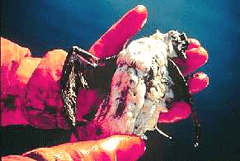
A volunteer in the 1989 clean-up handles an oil-soaked bird following the Exxon Valdez spill. (Photo: Alaska State Archives)
LANGE: The last time I tried fishing herring, we worked for over 22 days straight and we lost money. But that wasn’t the sad part. What was sad was returning to these bays, which used to be so full of life, and instead of seeing maybe 50, 60 pods of sea lions, I would be seeing maybe one. Instead of seeing whales everywhere, I would see none. Instead of seeing the bay boil with herring, I’d see a few herring here and there. And because the herring weren’t there, the birds weren’t there.
CURWOOD: So, these species that took a hit that you pointed out, back then they took obviously a very serious hit. What improvement, if any, from 1999?
GIBBONS: Well Sylvia’s a good friend and an amazing fisherwoman and she’s referring to exactly some of the things I was mentioning. The herring took such a large hit at that time that the biomass was significantly affected and the result of that is that the population has not really recovered to a sustainable level and of course that then, as Sylvia’s mentioning, has implications for the species that depend on it. And it’s true you do hear you know, fishermen and native people who have known the sound for a long time, they talk about some of the things that Sylvia’s mentioning- places that used to be vibrant with not only life but the sound of life are significantly different.
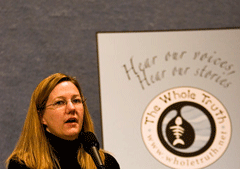
Jennifer Gibbons, Executive Director, Prince William Soundkeeper. (Photo: Dakote Fine)
GIBBONS: Well, all aspects of the community are still suffering from the corrosive effects of 19 years of litigation and you know, recovery. The communities are functioning differently. I think, speaking with Travis, you know, talking about what happened in the village with Tatitlek. Their whole lifestyle has been permanently altered and so they’re struggling to deal with that and find new ways, new economic opportunities to sustain their community. When you talk about a community like Cordova, that’s a fishing community, it’s a very simple, rustic, hard-working place, and you can see the economic impact. When you talk to the fisherman, every year it’s so important for them to break even in what they’re doing. Getting beyond that is secondary but they’ve got to break even to keep going.
CURWOOD: Exxon says that it’s made the Sound whole, that the environment is cleaned up, it shouldn’t be punished. You’re laughing.
GIBBONS: I’m definitely laughing at Exxon. They’re statements are simply offensive and they’re offensive to Alaskans and they’re offensive to all Americans. Exxon is banking on the fact that people have forgotten and punitive damages are intended as punishment and deterrents. But the bottom line is, for these people, it’s not about the money. It’s about justice. And it’s about holding Exxon accountable and it’s about the fact that they did the crime- they need to do the time. And in this case, the time is paying the punitive damages. They don’t want to pay it because they don’t want to be responsible in the future. And that’s why this case, it’s not just about Alaskans and 1989. It’s about the future of protecting clean water across the United States.
CURWOOD: Thank you, Jennifer Gibbons. You’re the executive director of Prince William Soundkeeper.
GIBBONS: Thank you very much.
CURWOOD: Joining me now is Ken Cohen, on the line from Dallas, Texas. He’s the vice president of public affairs for ExxonMobile. Hello, sir.
COHEN: Hello.
CURWOOD: Now, when I asked Jennifer Gibbons, who’s the Prince Williams Soundkeeper about your company’s claim that it has made Prince William Sound whole, she- well, she literally laughed.
COHEN: Well, I’m surprised and it’s unfortunate that that was the response. The fact is we accepted responsibility immediately for the accident and we did the only thing we could do at the time, which was to put our people and our money to work to clean it up. And we have spent three and a half billion dollars over the years in restoring the Sound, and cleaning up the cost, and compensating individuals for their economic losses. Now the fact is that when an oil spill occurs, particularly one of the size of the Valdez, it is a traumatic event. But over time, first with the cleanup we did, and then as nature takes its course, the Sound recovers.

Exxon Valdez grounded on Bligh Reef. (Courtesy of NOAA)
COHEN: You know, I’m glad actually that the question was put that way because what company, having gone through what our company has gone through- first just the trauma of going through the incident, accepting responsibility, paying the billions and billions in cleanup costs, and now of course dealing with the question of whether punitive damages would be appropriate in this case- what company believes that they’ve gotten away with something? Our company has been put through the ringer. And it’s significant for ExxonMobil and it’s also significant for all companies and businesses that operate here in the U.S.
You know, we live in a very litigious society and trial lawyers in any case, of any consequence, now as a matter of routine, ask the court to award punitive damages and we’re pleased now that the Supreme Court has another opportunity to provide guidance to the judicial system in the U.S. and to those situations when it really is appropriate to make that rare award of punitive damages.
CURWOOD: So how much have you paid in terms of punishment so far, you say you’ve already paid-
COHEN: We’ve paid three and a half billion dollars in the form of fines and penalties and cleanup costs.
CURWOOD: Okay, take out the cleanup costs- setting things right. And what have you paid in terms of the punitive side of this?
COHEN: I would lump- I don’t know how you can separate. These are all punishments in terms of- remember we also had a U.S. Attorney’s Office-
CURWOOD: I’m sorry I don’t mean to be rude here but let’s be clear. You say that there are criminal sanctions here, so there have been criminal penalties.
COHEN: We’ve paid the largest criminal fine to date for an environmental violation. The criminal fines with the U.S. federal government and the state government were over $125 million dollars.
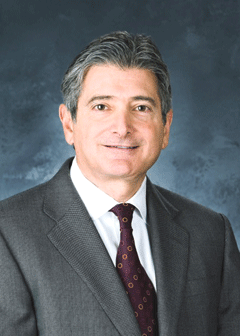
Ken Cohen is the Vice President of Public Affairs at Exxon Mobil Corporation (Photo: Exxon Mobil Corporation)
COHEN: Those are not the facts of our case.
CURWOOD: Well you had a drunk driver vanish from the wheel of your Exxon Valdez, I think that there is I think some parallels here.
COHEN: Well, again, I would argue, and my view certainly is that this instance we had a tragic accident for one we’ve taken or accepted responsibility. We’ve done everything in our power to cleanup the consequences of the spill. We believe that the three and a half billion dollars in cleanup costs, compensation and fines and penalties that we’ve paid up to this point- those are the facts of the case. That’s what we’re dealing with.
CURWOOD: Speaking about money and Exxon’s earnings and profits. If you were to pay the two and a half billion dollars, it would seem that you could well afford this. It would be what, about a fifth of your last quarter’s profits. Given the kind of public relations question that this raises about your company, why wouldn’t it make sense just to pay up and put this behind you?
COHEN: This is not a question of having the financial wherewithal to pay. The question is ‘is this an appropriate case, an appropriate instance for which punitive damages should be awarded?’ And our position is ‘no.’
CURWOOD: Ken Cohen is vice president of public affairs for ExxonMobil. Thank you so much, sir.
COHEN: Thank you.
[MUSIC: Anat Fort “Just Now.Var 1” from A Long Story (ECM Records 2007)]
CURWOOD: More than 33,000 people and businesses are plaintiffs in the lawsuit, which means they would get about $75,000 each, if the Supreme Court rejects Exxon’s appeal and lets the punitive damage award stand. The high court ruling is expected in a few months.
Related links:
- Prince William Soundkeeper
- Exxon Mobil Corporation
- To read Living on Earth's Special Report: "Exxon Valdez Ten Years Later" from March 5, 1999 click here
- National Oceanic and Atmospheric Administration "Spotlight" on the Exxon Valdez
- Valdez Oil Spill Photographs
Emerging Science Note/Diatoms
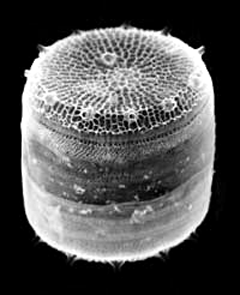
Diatoms are unicellular algae. This Thalassiosira pseudonana has a hard outer shell of silica. (Courtesy of U.S. Department of Energy)
CURWOOD: Just ahead, why frogs have nothing to celebrate this Leap Year. But first this note on emerging science from Margaret Rossano.
ROSSANO: The pioneers of Silicon Valley probably never imagined that the key to faster computers might lie in algae – the simple, plant-like organisms that create red tides and make your fish tank murky.
But some scientists now think that diatoms - a kind of algae that lives in the ocean - might help them build speedier computer chips.

Diatoms are unicellular algae. This Thalassiosira pseudonana has a hard outer shell of silica. (Courtesy of U.S. Department of Energy)
Genetic control of silica production could be a major breakthrough when it comes to manufacturing computer chips. Currently, the circuit patterns on chips are cut with beams of ultra violet light, but diatoms could produce much finer lines. More lines mean room for even more transistors—the millions of tiny electrical switches that are the building blocks of computer chips—and a faster chip overall.
The research team hopes they can control and guide the diatoms silica-making, so that someday these microscopic algae can help produce a faster computer for you.
And that’s this week’s note on emerging science. I’m Margaret Rossano.
CURWOOD: Coming up- emerging science of the brain and some unexpected perils of poverty. Keep listening to Living on Earth.
This Is Your Brain on Poverty
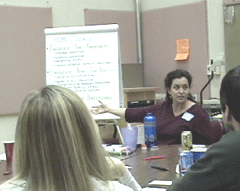
Dr. Jessica Fanning of the University of Oregon, who developed the parent training program, meeting with groups of families. (Photo: University of Oregon)
ANNOUNCER: Support for the environmental health desk at Living on Earth comes from the Cedar Tree Foundation. Support also comes from the Richard and Rhoda Goldman Fund for coverage of population and the environment. This is Living on Earth on PRI, Public Radio International.
[MUSIC: Dean Frasier: “Bank Of The River” from Big Up (Island Jamaica Jazz 1997)]
CURWOOD: It’s Living on Earth, I’m Steve Curwood. Let’s face it. Life can be stressful, and too much stress can be toxic. If there’s too much to do or too many bills to pay, the price can be a heart attack or a descent into depression. And now emerging brain science is finding more and more evidence that stress adversely affects infants and children and can lead to damage that may last a lifetime. This research also offers insights into the persistence of poverty. Living on Earth's Emily Taylor has our report.
TAYLOR: A child's brain is fragile, vulnerable to many outside influences like television, video games, and playmates. And though child advocates often complain about the ill effects of TV and advertising on young brains, scientists now think that childhood poverty may be one of the most damaging influences of all.
FARAH: I guess it's kind of obvious that living in poverty results in a lot more stress in your life.
TAYLOR: That's Martha Farah, Director of the Center for Cognitive Neuroscience at the University of Pennsylvania.

Martha Farah, Director of the Center for Cognitive Neuroscience, University of Pennsylvania. (Courtesy of Martha Farah)
TAYLOR: And Courtney Stevens of the University of Oregon says there's no question this stress causes harm: not just to parents, but also to their children's brain development.
STEVENS: What we know is that poverty has a way of crawling under the skin and getting into the brain. We know one of the big mechanisms whereby this happens is through stress – that high levels of stress for a child in a sense produces a toxic environment within that child's body for healthy brain development and healthy cognitive skills.

Courtney Stevens, Research Fellow at the Brain Devlopment Lab, University of Oregon. (Courtesy of Courtney Stevens)
Essentially this research showed that a mother rat can buffer her offspring from stress by being attentive and nurturing. And if she does this, if she grooms, licks, and nurses her litter, her babies are more likely to develop normally, specifically in the area of the brain responsible for memory – the hippocampus.
That's because the hippocampus is highly sensitive to the stress hormone cortisol, say the researchers. Cortisol prepares the body for the "fight or flight" response. It sends signals to the hippocampus saying 'hey remember what's happened' so that next time the situation can be avoided. But repeated stress can damage the hippocampus. So in rats, if the mother doesn't nurture her baby – say if she's separated from it – it will later perform poorly on memory tests.

Dr. Jessica Fanning of the University of Oregon, who developed the parent training program, meeting with groups of families.
(Photo: University of Oregon)
Farah says poor maternal nurturing can often be because the mother's depressed.
FARAH: So stress we know is itself neurotoxic: it impacts the developing nervous system. In addition, there are factors like the greater incidence of maternal depression in poor families, and we know from studies of people at all income levels that maternal depression is actually very bad for child development. When moms are depressed they pay less attention to the kids. They engage with them less, they are less, you know, warm and involved, because they're depressed.
TAYLOR: Farah and her colleagues noted another association. When the environment was less stimulating, with fewer books and toys and less-engaged parents, the poorer the child's language skills were later in life. These results weren't totally surprising – rat studies show that cages with more toys will lead to positive brain changes in the rodent. So improving a child's memory and language skills may be as simple as targeting the parents. And that's exactly what Courtney Stevens and her colleagues at the University of Oregon are aiming to do.

(Photo: University of Oregon)
TAYLOR: And these increased intelligence and language skills are the keys to success for children – both at school and in life.
For Living on Earth, I'm Emily Taylor.
Related links:
- Neuroethics at the University of Pennsylvania
- The Brain Devlopment Lab at the University of Oregon
- American Association for the Advancement of Science
The Language of Landscape

Home Ground: Language for an American Landscape, edited by Barry Lopez and Debra Gwartney. (Courtesy of Trinity University Press)
[MUSIC: Daniel Lanois “O Marie (Homeground Theme)” from ‘Acadie’ (Daniellanois.com – 2005)]
CURWOOD: Though rising temperatures are already thawing the frozen seas, some features of the icy oceans are indelibly part of our landscape and language, and evocatively described in the book “Home Ground.”
Barry Lopez and Debra Gwartney created this compilation of landscape terms, to create pictures in our minds of the features of our planet. Today, Eva Saulitis reads her definition of – pack ice.
SAULITIS: Pack ice. In winter, a quixotic carapace of drifting sea-ice blankets millions of square miles of the Polar Ocean. In Nupiak Eskimo, called the permanent part of the polar pack, consisting of both multiple year and annual pack ice – a conga siku, mother ice. The English-language term is meant to include as well the extensive fields of younger, mobile ice of the year, the seasonal or annual ice that may stretch much farther to the South as winter settles in. During storms, pack ice cries out, grinding, screeching. Winds, tides, and currents mangle flows into pressure ridges, or rip them apart to form temporary open water leads.

Home Ground: Language for an American Landscape, edited by Barry Lopez and Debra Gwartney. (Courtesy of Trinity University Press)
Eskimos in arctic Alaska hold quite a different view. For these native people, annual ice forming over the continental shelf equals life. In summer, melting pack ice releases fresh water and nutrients, helping spin a food web – algae, flagellets, zooplankton, fishes, mammals. Polar bears and many species of seal and whale are entirely dependent on pack ice for survival. When the pack drifts far to the North, Eskimo hunters scan the seaward horizon expectantly for its reflection in the sky. Ice blink: a brightness in the clouds.
In recent years, summer pack ice, reduced by global warming, remains farther offshore and less accessible to hunters. In this century, if current projections of continuous climate warming are correct, the shrinking ice pack will transform the Northwest passage from occasional adventure to commonplace reality.
[MUSIC: Various Artists “All Alone (On Eilean Shona)” from One Giant Leap (Palm Pictures 2001)]
CURWOOD: Eva Saulitis is a biologist and writer from Homer, Alaska. Her description of Pack Ice comes from the book “Home Ground, Language for an American Landscape,” compiled by Barry Lopez and Debra Gwartney.
Related link:
Home Ground: Language for an American Landscape
Leaping Towards a Solution

Hyloscirtus colymba, currently housed at the El Valle Conservation Center in Panama. (Photo: Bill Konstant, Houston Zoo)
CURWOOD: 2008 isn’t just any year. It’s a leap year: the quadrennial event when the calendar plays catch-up with things celestial, and February has 29 days. To mark the leap, the Association of Zoos and Aquariums is turning to the quintessential leaper: the frog.
At some 90 zoos and aquaria across the country you’ll be able to compete in croaking contests and amphibian scavenger hunts, and of course, leap frog. But it won’t all be fun and games, says Shelly Grow of the Association. She says by making this leap year the Year of the Frog, the organization hopes to highlight the fight for survival for amphibians around the world. A third of the six thousand or so amphibian species face extinction from an unusual pathogen. Shelly Grow is on the line – so Shelly, tell me about this disease.

Gastrotheca cornuta, currently housed at the El Valle Conservation Center in Panama. (Photo: Bill Konstant, Houston Zoo)
CURWOOD: Where did this fungus come from and why is it so devastating?
GROW: The current hypothesis is that it has come from Africa and probably was shipped in the African clod frog, which in the ’thirties and ’forties was shipped around the world for use in pregnancy tests.
CURWOOD: Frogs in a pregnancy test?
GROW: Yes, this was…Actually it was a very popular pregnancy test and the idea was that if you injected some of a woman’s urine into an amphibian, if the amphibian were to lay eggs, then that would be a sign that the woman was pregnant. And what was great about this is that results – the amphibian would lay eggs within eight to 12 hours, so these were really quick results for a pregnancy test. Much quicker than previous tests had been. And this remained very common up until the ’sixties when other methods of detecting the hormone in women that were pregnant were discovered.
CURWOOD: Now, fungus is one really stressor on frogs, what are the other major factors that are threatening amphibians at this point?

Hyloscirtus colymba, currently housed at the El Valle Conservation Center in Panama. (Photo: Bill Konstant, Houston Zoo)
CURWOOD: So let me understand this, the zoos and aquaria are calling for the removal of frogs from their habitat in the face of this disease?
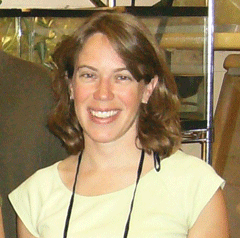
Shelly Grow, Conservation Biologist, Association of Zoos and Aquariums. (Photo: R. Andrew Odum Toledo Zoo)
CURWOOD: So, I have a pond in my backyard. Should I get out there with my net and capture some of these leapers and bring them in for the next couple years.
GROW: Absolutely not. The idea is that still the leading threat for amphibians is habitat loss and destruction, so if you have a pond in your backyard, the best thing is to make sure that it is healthy habitat for your local amphibians. So that there’s not lawn chemicals running off into it. Or that you’re not draining it to put in a basketball court or things like that. But the idea is that we really want to have habitat available for these amphibians.

Anotheca spinosa, currently housed at the El Valle Conservation Center in Panama. (Photo: Bill Konstant, Houston Zoo)
GROW: We’ve used them for anti-tumor properties, or we found anti-tumor properties, anti-inflamatories. There’s been some research saying there may be some compounds in some amphibians that may help against HIV, so that’s again, going back to the medical purposes. But then we also use them for – we benefit greatly from the insect control that they play for us. People are concerned about what would happen if there’s a huge die-off in amphibians, what would happen to insect-born diseases like yellow fever, or malaria? What would happen in agricultural fields if the amphibians are gone and not helping with pest control? And then there are the roles that they play in the wider ecosystem, a food web, what would happen to birds and snakes and spiders if their food source were to disappear in great numbers.

Hypsiboas rosenbergi, currently housed at the El Valle Conservation Center in Panama. (Photo: Bill Konstant, Houston Zoo)
GROW: You know, I actually don’t have a favorite amphibian. I can get so excited by just some of the names of some of these amphibians, like the hell bender, and that is also known as the snot otter, and all sorts of great salamanders, but then there’s some really just gorgeous, downright beautiful frogs out there as well, so… I don’t know. And then I’m pretty grateful for those that are eating the mosquitoes in my own backyard, so I don’t think I have a favorite.
CURWOOD: I guess I have to confess that my favorite probably is Kermit, even though he’s not a real frog, but a puppet.
GROW: He is awfully lovable and he has been a great celebrity on behalf of all amphibians out there.
CURWOOD: Shelly Grow is a conservation biologist with the Association of Zoos and Aquariums. Thanks so much, Shelly.
GROW: Thank you so much for having me.
CURWOOD: To learn more about The AZA’s Year of the Frog activities, leap on over to our web site: L-O-E dot O-R-G.
[MUSIC: “It’s Not Easy Being Green” (You Tube video from Sesame Street)]
Related link:
Association of Zoos and Aquariums' page on Leap Day
On the next Living on Earth – what we share with the mighty whales.
PAYNE: My suspicion is, is that the vertebrate brain – whether it’s in the head of a whale or the head of a human being – is entertained by pretty much the same kinds of things. To me that suggests the following: that music is probably older than our species – a lot older than our species.
CURWOOD: And now scientists are finding that whales are literally changing their tune. That’s next time on Living on Earth.
[EARTHEAR: (Track 8, “Voices of the Swamp,” Lang Elliott and Ted Mack. © 1996 Lang Elliott Nature Sound Studio)]
CURWOOD: We leave you this week with a “ribbiting” amphibian concert.
[Lang Elliott & Ted Mack “Pig Frog Concert” from Voices Of The Swamp (Nature Sound Studio 1996)]
CURWOOD: Pig Frogs are the featured crooners at a wet, grassy prairie in Okefenokee National Wildlife Refuge in Georgia. Backup singers include Cricket and Carpenter Frogs. Lang Elliott and Ted Mack recorded this symphony for their CD “Voices of the Swamp.”
Living on Earth is produced by the World Media Foundation. Our crew includes Ashley Ahearn, Bobby Bascomb, Eileen Bolinsky, Bruce Gellerman, Ingrid Lobet, Helen Palmer, and Jeff Young, with help from Jennifer Baessler, Sarah Calkins, Mitra Taj and Kathleen O’Neill. Our interns are Annie Jia and Margaret Rossano.
Jeff Turton is our technical director. Alison Lirish Dean composed our themes. You can find us any time at loe.org. I'm Steve Curwood. Thanks for listening.
ANNOUNCER: Funding for Living on Earth comes from the National Science Foundation, supporting coverage of emerging science; Stonyfield Farm, organic yogurt and smoothies. Stonyfield Farm pays its farmers not to use organic growth hormones on their cows. Details at Stonyfield.com. Support also comes from you our listeners, the Ford Foundation, the Town Creek Foundation, the Oak Foundation, supporting coverage of climate change and marine issues, and Pax World Mutual Funds, socially and environmentally sustainable investing. Pax World: for tomorrow. On the web at paxworld dot com.
ANNOUNCER: PRI: Public Radio International.
Living on Earth wants to hear from you!
Living on Earth
62 Calef Highway, Suite 212
Lee, NH 03861
Telephone: 617-287-4121
E-mail: comments@loe.org
Newsletter [Click here]
Donate to Living on Earth!
Living on Earth is an independent media program and relies entirely on contributions from listeners and institutions supporting public service. Please donate now to preserve an independent environmental voice.
NewsletterLiving on Earth offers a weekly delivery of the show's rundown to your mailbox. Sign up for our newsletter today!
 Sailors For The Sea: Be the change you want to sea.
Sailors For The Sea: Be the change you want to sea.
 The Grantham Foundation for the Protection of the Environment: Committed to protecting and improving the health of the global environment.
The Grantham Foundation for the Protection of the Environment: Committed to protecting and improving the health of the global environment.
 Contribute to Living on Earth and receive, as our gift to you, an archival print of one of Mark Seth Lender's extraordinary wildlife photographs. Follow the link to see Mark's current collection of photographs.
Contribute to Living on Earth and receive, as our gift to you, an archival print of one of Mark Seth Lender's extraordinary wildlife photographs. Follow the link to see Mark's current collection of photographs.
 Buy a signed copy of Mark Seth Lender's book Smeagull the Seagull & support Living on Earth
Buy a signed copy of Mark Seth Lender's book Smeagull the Seagull & support Living on Earth

